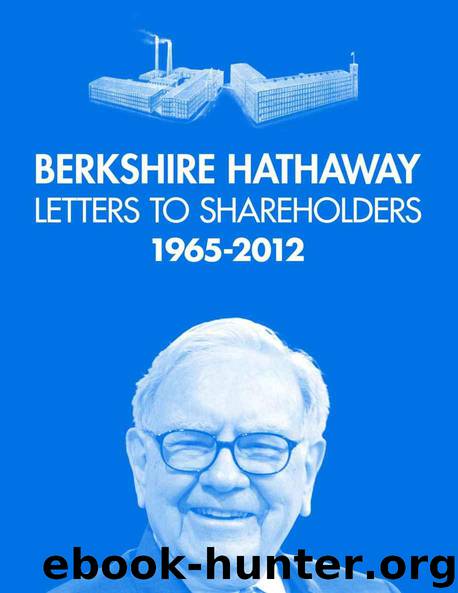Berkshire Hathaway Letters to Shareholders by Buffett Warren

Author:Buffett, Warren [Buffett, Warren]
Language: eng
Format: mobi, epub
Publisher: Max Olson
Published: 2013-04-24T22:00:00+00:00
BERKSHIRE HATHAWAY INC.
Chairman’s Letter
To the Shareholders of Berkshire Hathaway Inc.:
Our gain in net worth during 1996 was $6.2 billion, or 36.1%. Per-share book value, however, grew by less, 31.8%, because the number of Berkshire shares increased: We issued stock in acquiring FlightSafety International and also sold new Class B shares.* Over the last 32 years (that is, since present management took over) per-share book value has grown from $19 to $19,011, or at a rate of 23.8% compounded annually.
* Each Class B share has an economic interest equal to 1/30th of that possessed by a Class A share, which is the new designation for the only stock that Berkshire had outstanding before May 1996.Throughout this report, we state all per-share figures in terms of “Class A equivalents,” which are the sum of the Class A shares outstanding and 1/30th of the Class B shares outstanding.
For technical reasons, we have restated our 1995 financial statements, a matter that requires me to present one of my less-than-thrilling explanations of accounting arcana. I’ll make it brief.
The restatement was required because GEICO became a wholly-owned subsidiary of Berkshire on January 2, 1996, whereas it was previously classified as an investment. From an economic viewpoint—taking into account major tax efficiencies and other benefits we gained—the value of the 51% of GEICO we owned at year-end 1995 increased significantly when we acquired the remaining 49% of the company two days later. Accounting rules applicable to this type of “step acquisition,” however, required us to write down the value of our 51% at the time we moved to 100%. That writedown—which also, of course, reduced book value—amounted to $478.4 million. As a result, we now carry our original 51% of GEICO at a value that is both lower than its market value at the time we purchased the remaining 49% of the company and lower than the value at which we carry that 49% itself.
There is an offset, however, to the reduction in book value I have just described: Twice during 1996 we issued Berkshire shares at a premium to book value, first in May when we sold the B shares for cash and again in December when we used both A and B shares as part-payment for FlightSafety. In total, the three non-operational items affecting book value contributed less than one percentage point to our 31.8% per-share gain last year.
I dwell on this rise in per-share book value because it roughly indicates our economic progress during the year. But, as Charlie Munger, Berkshire’s Vice Chairman, and I have repeatedly told you, what counts at Berkshire is intrinsic value, not book value. The last time you got that message from us was in the Owner’s Manual, sent to you in June after we issued the Class B shares. In that manual, we not only defined certain key terms—such as intrinsic value— but also set forth our economic principles.
For many years, we have listed these principles in the front of our annual report, but in this report, on pages 58 to 67, we reproduce the entire Owner’s Manual.
Download
Berkshire Hathaway Letters to Shareholders by Buffett Warren.epub
This site does not store any files on its server. We only index and link to content provided by other sites. Please contact the content providers to delete copyright contents if any and email us, we'll remove relevant links or contents immediately.
The Black Swan by Nassim Nicholas Taleb(6762)
Bad Blood by John Carreyrou(6274)
Pioneering Portfolio Management by David F. Swensen(6078)
Millionaire: The Philanderer, Gambler, and Duelist Who Invented Modern Finance by Janet Gleeson(4092)
Skin in the Game by Nassim Nicholas Taleb(3965)
The Money Culture by Michael Lewis(3846)
Bullshit Jobs by David Graeber(3826)
Skin in the Game: Hidden Asymmetries in Daily Life by Nassim Nicholas Taleb(3720)
The Wisdom of Finance by Mihir Desai(3523)
Blockchain Basics by Daniel Drescher(3327)
Liar's Poker by Michael Lewis(3220)
The Intelligent Investor by Benjamin Graham Jason Zweig(2930)
Hands-On Machine Learning for Algorithmic Trading by Stefan Jansen(2925)
Mastering Bitcoin: Programming the Open Blockchain by Andreas M. Antonopoulos(2891)
Fooled by Randomness: The Hidden Role of Chance in Life and in the Markets by Nassim Nicholas Taleb(2860)
Investing For Dummies by Eric Tyson(2791)
The Power of Broke by Daymond John(2770)
Market Wizards by Jack D. Schwager(2538)
Zero Hour by Harry S. Dent Jr. & Andrew Pancholi(2531)
